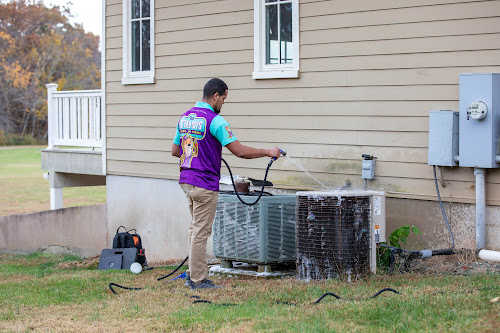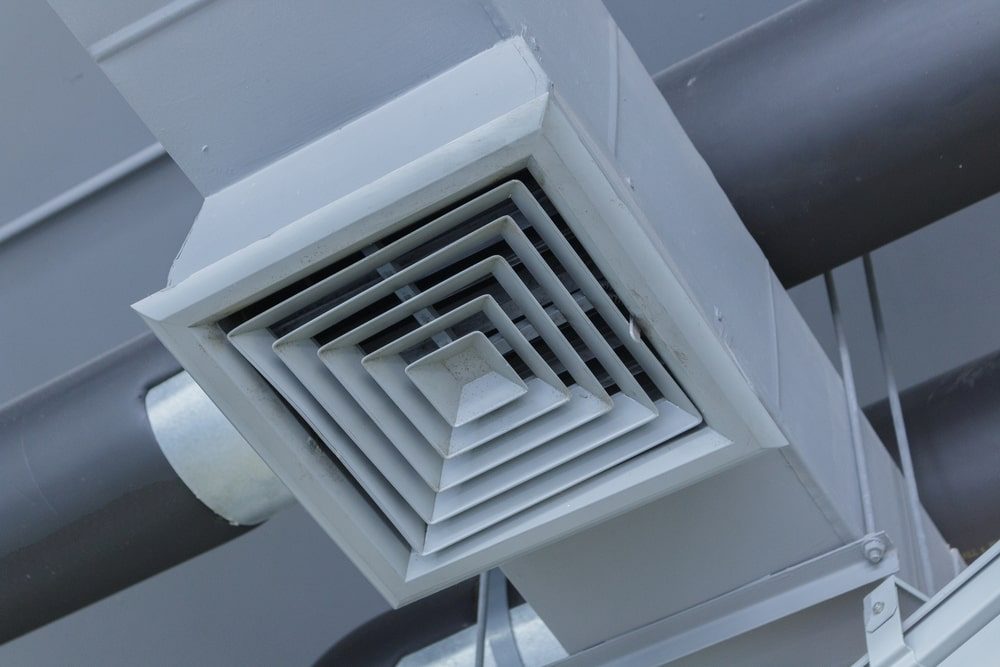Introduction
If you live in Charlottesville, Virginia you understand the crucial role a well-functioning air conditioning system plays in maintaining comfort in our diverse climate. Here at The Otter Guys, we have built our reputation as the leading heating and air conditioning company by ensuring our clients have an uninterrupted flow of cool, clean air in their homes and businesses. In this blog post, we will explore the five most common AC repairs we encounter and provide insights on how to avoid them.

1. Filter Replacement
One of the most common AC repairs involve the air filter. Air filters work by trapping and filtering out dust, allergens, and debris from the air circulated through your home. Over time, these filters can become clogged, reducing the efficiency of the airflow through your AC system.
Clogged filters force your AC system to work harder, leading to increased energy consumption and the potential for overheating, causing internal damage. This can escalate into more serious problems, such as a complete system breakdown. Common signs of a clogged filter include unusual noises from the unit, reduced airflow, or the system blowing warm air.
To avoid this, regular filter checks and replacements are necessary. At The Otter Guys, we recommend changing your filter every 1-3 months depending on your system’s usage, filter type, and whether you have pets. We offer professional AC servicing and can assist in determining the best filter for your specific system needs.
2. Refrigerant Leaks
Refrigerant leaks are one of the most common AC repairs that we come across. This is an issue that can significantly impact the performance of your AC system. As your AC works to cool your home, the refrigerant absorbs heat from the indoor air and releases it outside. If your system is low on refrigerant, this cooling process is hampered, resulting in a noticeable decline in performance.
Common symptoms of a refrigerant leak
The common symptoms of a refrigerant leak can include:
- Decreased cooling capacity: Your AC may run for extended periods without adequately cooling your home.
- Ice formation on the AC’s components: Low refrigerant levels can cause the evaporator coil to freeze, which may lead to ice formation on the AC unit.
- Hissing or bubbling noises: These sounds could be a sign of a refrigerant leak in your AC system.
Refrigerant leaks aren’t just a matter of system performance—they can be a serious environmental concern. Certain types of refrigerants, like Freon (also known as R-22), are ozone-depleting substances. Even though production of R-22 was phased out in 2020, many older systems still operate on this refrigerant.
Repairing refrigerant leaks involves a few key steps:
Leak Detection
Professional HVAC technicians have various methods for detecting leaks. They might use electronic leak detectors, ultraviolet (UV) dye, or soap bubble solution. These methods help identify the exact location of the leak.
Repairing or Replacing Components
Once the leak has been located, the technician will then decide whether to repair the leak or replace the faulty component. Small leaks can often be sealed, but larger leaks or multiple leak points may necessitate part or component replacement.
Refrigerant Recharge
After the leaks have been addressed, your AC system will need to be recharged to the correct refrigerant level as specified by the manufacturer. This process should always be done by a professional to ensure the correct amount is added.
System Test
Finally, the technician will test the system to ensure it is working correctly and efficiently. This may include checking the cooling function, inspecting for any further leaks, and assessing overall system performance.
It’s worth noting that while some older AC systems may still be using R-22 refrigerant, since the phase-out, it’s recommended to consider upgrading to a newer AC system that uses a more environmentally friendly refrigerant if leaks become a recurrent issue.
Refrigerant leaks are complex issues that need a professional’s touch. At The Otter Guys, our team of certified technicians is experienced in diagnosing and repairing refrigerant leaks, ensuring your system performs at its best while keeping environmental impact to a minimum.
3. Thermostat Issues
The thermostat serves as the control panel for your HVAC system. Any malfunction here can lead to inconsistent temperature control, causing discomfort. Some of the most common AC repair issues are related to the thermostat. Common issues range from incorrect calibration, wiring issues, and sometimes, simple battery changes.
Older, mechanical thermostats can develop calibration problems over time. On the other hand, modern, digital thermostats can experience issues due to sensor malfunctions or software glitches. Regardless of the type, regular thermostat checks can help identify any problems early on.
With The Otter Guys, our comprehensive HVAC service includes a thorough inspection of your thermostat to ensure it’s sending the correct signals to your AC system. We’re also happy to guide you in upgrading to a programmable or smart thermostat for increased energy efficiency.
4. Drainage Problems
Air conditioning units don’t just cool air — they also dehumidify it. The moisture they extract from the air is removed from your home through the condensate drain line. However, this drain line can sometimes become blocked due to dust, mold, or algae buildup. A blocked drain line can cause water to back up, leading to potential water damage to your system or your home. Drain line issues are among the most common AC repairs.
Common signs of drainage issues
Common signs of drainage problems include:
- Water leaks around the system: If your AC is leaking water, it could be due to a clogged condensate drain line.
- High indoor humidity levels: Your AC unit not only cools the air but also reduces humidity. If the humidity level seems unusually high, this could indicate a problem with your AC unit’s drainage system.
If you suspect a drainage problem, it’s best to call a professional AC technician. Here’s how a technician would typically address the issue:
Inspecting the Drain Pan and Line
The technician will begin by inspecting the drain pan and line for any obvious signs of clogging or damage. If the pan is full or overflowing, this is a clear sign of a blockage somewhere in the drain line.
Clearing the Blockage
If a blockage is found, the technician will then use a specialized vacuum to suck out the blockage. This might be done several times until the blockage is completely removed. In severe cases, a chemical cleaning agent may be used to help break down the blockage.
Flushing the Line
Once the blockage has been removed, the technician will typically flush the line to ensure it’s completely clear. This also helps to remove any remaining residue from the chemical cleaning agent if one was used.
Checking the Condensate Pump (if applicable)
If your system is equipped with a condensate pump, the technician will also check to make sure this is working correctly. The pump helps to move condensate water to the outside of your home, and any problems with this could lead to backup or overflow.
Preventative Measures
After the drain line is cleared, the technician might recommend some preventative measures. This could include regular application of a non-corrosive drain line treatment to prevent algae and mold growth. In some cases, it might be necessary to install a safety switch that automatically shuts off the AC system if a clog is detected in the future.
At The Otter Guys, our team of certified technicians is experienced in diagnosing and resolving drainage problems, preventing costly water damage to your AC system and home. We also provide advice and solutions for preventing future drainage issues, ensuring your AC system functions optimally for as long as possible.
5. Fan Problems
Air conditioning systems consist of two fans: the blower fan, which circulates cool air into your home, and the condenser fan, which expels heat absorbed by the refrigerant to the outdoors. Issues with either fan can impact the efficiency of your AC system, leading to decreased cooling capacity, increased energy consumption, and the potential for system overheating.
Common Fan Issues
Common symptoms of fan problems include:
- Insufficient airflow: If the fan isn’t moving air as it should, you may notice a decrease in the amount of cool air coming from your vents.
- Noises: Unusual noises, such as rattling or buzzing, can indicate a problem with the fan.
- The system isn’t cooling: If the fan is running but the air isn’t cool, this could indicate a problem with the condenser fan.
If you’re experiencing any of these issues, it’s best to call a professional HVAC technician. Here’s how a technician might diagnose and address fan problems:
Physical Inspection
The technician will start with a physical inspection, checking for any obvious signs of damage or blockage. Debris buildup, loose screws, or damaged fan blades can all affect the operation of the fan.
Electrical Testing
If no physical issues are found, the technician may perform some electrical tests to check for motor or wiring problems. This might involve using a multimeter to measure voltage and resistance.
Fan Motor Inspection
The fan motor is a crucial component that powers the fan. If the technician suspects an issue with the motor, they will inspect it for signs of overheating or wear and tear. Burnt wiring, unusual noises, or the motor not running could all indicate a motor issue.
Fan Belt Inspection
For some AC systems, the technician might also check the fan belt. A worn or damaged belt can affect the operation of the fan. The technician will inspect the belt for any signs of fraying, cracking, or loosening.
Repair or Replacement
Based on the findings, the technician may then carry out the necessary repairs. This could involve cleaning the fan, tightening loose components, replacing a faulty motor, or installing a new fan belt. In some cases, if the fan is extensively damaged, the best course of action may be to replace the entire fan.
Fan-related issues can have a major impact on the performance of your AC system. At The Otter Guys, our team of certified technicians has the expertise to diagnose and resolve fan problems, ensuring your AC system operates efficiently and cools your home effectively. We also offer regular maintenance services to help prevent fan issues and prolong the life of your AC system.
Conclusion: Most Common AC repairs
While these are the most common AC repairs we encounter at The Otter Guys, a well-maintained system can avoid many of these issues. Regular maintenance not only ensures a comfortable home environment but also saves you money in the long run by reducing the need for frequent repairs and enhancing your system’s energy efficiency. Keeping up with routine checks also extends the lifespan of your system, ensuring it serves you well for many years.
At The Otter Guys, we understand that every air conditioning system has its unique needs. That’s why we offer personalized maintenance plans to ensure optimal performance for your specific system. Our team of certified technicians has the knowledge and expertise to identify potential issues early and provide the right solutions to keep your AC running smoothly.
In Charlottesville, Virginia, we experience the full range of weather conditions, from freezing winters to scorching summers. As such, having a reliable, efficient, and well-maintained air conditioning system is a necessity, not a luxury. When you need to replace your air conditioning system, or repair services or regular maintenance for your AC system, remember that The Otter Guys are just a call away.
And don’t forget – preventing problems is always better (and cheaper!) than fixing them. By identifying potential issues early, you can avoid the discomfort of a failing AC and enjoy the peace of mind that comes from a perfectly functioning system.





